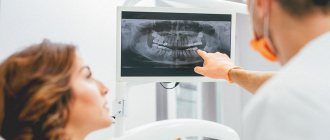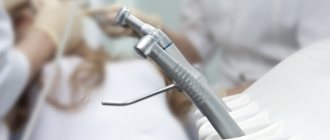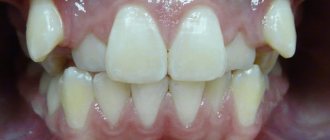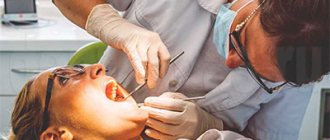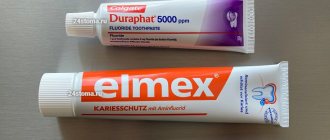Different types of braces Imaging diagnostic methods are necessary to identify diseases and make the correct diagnosis. One of the most popular is magnetic resonance imaging. The method is non-invasive, absolutely safe for health, and has a minimum of contraindications. One of the limitations is the presence of metal structures in the patient’s body. We are talking about endoprostheses, implants, pacemakers, hearing correction devices or orthodontic devices. The possibility of undergoing an MRI with braces or retainers is the most common reason for discussion, because... bite correction structures cannot be quickly removed without the help of a dentist.
Is it possible or not to do an MRI with braces on teeth?
Magnetic resonance imaging can be performed with braces on the teeth, however, when performing diagnostics, it is necessary to take into account some nuances:
- what material is the orthodontic structure made of?
- what part of the body is exposed to magnetic influence;
- Are there alternative diagnostic options?
MRI of the brain
It is possible to do an MRI of the brain with braces. In the manufacture of most modern orthodontic systems, metals are not used, which can affect the outcome of the diagnosis. It is necessary to check with your dentist exactly what alloys were used to make these braces.
Some metals may resonate with the magnetic field during diagnostic testing. This will result in the study being slightly biased. Therefore, it is important to have an idea of the technology for making corrective plates and, based on this, evaluate the feasibility of tomography.
With retainers installed
Retainers are thin metal plates that are installed on the inside of the tooth after the bite is corrected with braces. In most cases, they do not affect brain MRI readings.
Important!
Studies have shown that multi-wire retainers did not cause significant distortions in diagnostic results.
If tomography is performed in another area, the patient may not worry about the reliability of the results. With braces and retainers, they cannot be distorted, since the structures do not enter the magnetic field space.
Method information
MRI in medicine is considered the safest and most effective diagnostic method, which allows doctors to accurately and quickly determine the location, severity of the disease, and any abnormalities in the functioning of the human body.
In short, magnetic resonance imaging is a scan of the human body, and unlike CT or radiography, it operates on a slightly different principle.
This technique is based on the interaction of the magnetic properties of human tissue and an artificially created magnetic field.
Thanks to this interaction, the condition of cartilage, soft tissues, organs, brain, spine, and ligaments is assessed extremely accurately. That is, those structures of the body that contain a large volume of liquid are examined.
This diagnostic technique is the most effective for the early detection of malignant neoplasms, inflammation, disorders in the central nervous system, joints, spine, musculoskeletal system, pelvic and abdominal organs, and blood vessels.
The advantages of the technique include:
- Possibility of obtaining a more detailed image of the object being examined.
- It is possible to examine those places in the body where the use of CT will be ineffective.
- There is no ionizing radiation to the patient.
- It provides not only a detailed image of the structure of an organ/tissue, but also displays the degree of its functioning.
- You can perform an examination with the introduction of a contrast agent, which significantly increases the diagnostic potential.
- An unmistakable examination result.
To carry out the procedure, special equipment is used: a powerful computer and a tomograph (scanning device of a closed, partially closed, or completely open type).
Open-type tomographs are usually used to examine obese people, as well as those who suffer from attacks of claustrophobia.
Depending on the area of the area being examined, the duration of the procedure is 30-60 minutes. (in some cases up to 2 hours).
The images are interpreted by a radiologist, but in special situations, highly specialized specialists are involved in the interpretation of the image.
Before the examination, the patient is asked to remove all or part of his clothing (it all depends on the area of study). If some items of clothing are allowed to remain, it is important to remove all metal objects from pockets.
How do metal parts react when examined in a tomograph?
There is a stereotype that tomography cannot be done with metal braces. Reviews from some patients indicate that the structure is attracted by a magnet, heats up, emits harmful substances and can completely deteriorate. These myths are supported by people's imagination, since none of the hypotheses have been confirmed.
On a note!
A person with braces does not feel anything unusual during an MRI of the head. The examination is the same as without orthodontic construction. Nothing gets hot, explodes or gets damaged.
Is there any harm to the body?
We have found that there is no pain or discomfort during diagnosis with braces or retainers on the teeth.
However, patients are worried that there is some “hidden threat” from such procedures and the dangerous consequences are macroscopically invisible and will certainly appear in the future. Doctors assure that such a judgment is erroneous - there is no harm from the research.
Magnetic field braces do not become magnetized, are not deformed, and do not change the bite or position of the teeth.
The structures do not adversely affect the brain and sensory organs. The main thing that is recommended to be wary of is ignoring contraindications to the study.
Important are the 1st and 3rd trimester of pregnancy, the presence of an insulin pump or pacemaker (devices break due to the magnetic field).
Patient misconceptions about the effect of magnets on braces
Some patients refuse the procedure because they consider MRI and a retainer (braces) to be incompatible. Main misconceptions:
- if you do a magnetic examination with an orthodontic design, the result will be unreliable, and the examination itself will be useless;
- the magnetic tomography device affects the tension force of the corrective arc, after which the staples become useless;
- when exposed to a magnetic field, the metal releases toxic substances that are dangerous to humans;
- when manipulated, the plates heat up and can peel off from the tooth;
- a magnet can attract locks and arches, so doing an examination is dangerous.
Important!
None of the assumptions has a scientific evidence base, so they are all considered patient misconceptions. If there are concerns about the effectiveness and safety of this diagnosis, it is worth listening to the opinions of several specialists.
The essence of the method: what are the concerns of patients
The diagnostic method is based on the phenomenon of nuclear magnetic resonance: a living organism consists of cells, cells are made of molecules, and they are made of atoms of chemical elements. Inside every atom there is a positively charged nucleus. If you place it in a high-intensity magnetic field, it reacts to it, which is manifested by the transition of the atom to an excited state.
All human organs consist of different tissues, and they are made of different molecules and atoms. And each type of chemical element reacts to a magnetic field in a unique way. Reading their reaction to the influence of the magnetic field of the tomograph, the device scans the area under study. The computer helps process data by converting the received information into a two-dimensional or three-dimensional picture.
The concern of orthodontic patients is that some metals can become magnetized, and the magnetic field inside the scanner is very strong. What can happen if you perform a diagnostic procedure with braces or other metal objects?
An alternative method of examination with braces is CT
Computed tomography is an alternative to magnetic scanning. The main difference between them is that MRI uses magnetic influence, while CT uses X-rays.
You can do a CT scan with braces. Orthodontic treatment is not a significant contraindication for examination. The only nuance that experts take into account is the material used to make the correction system. During an x-ray, it can be recorded by the system. Therefore, when interpreting the results, it is necessary to pay attention to the error. Automatic interpretation of results may be distorted and show a pathological process where it actually does not exist.
What to do if the results are distorted
If braces cause distortions in the images, it is possible to conduct a second examination or, if possible, use another diagnostic method. In some cases, this examination method can be replaced by another diagnostic method, for example, computed tomography. In extremely rare cases, radiologists insist on removing braces if the risk of obtaining unreliable results is too great. In any case, the presence of such a system is not an absolute contraindication to diagnostics. But to obtain the most accurate information after diagnosis, it is necessary to warn specialists about their presence.
Reviews
In the capital, almost every medical institution has a tomograph and everyone is examined indiscriminately. When I was scheduled for pelvic diagnostics, I had braces. I thought that the procedure would be postponed until the end of treatment or the plates would be removed ahead of schedule. But the doctor convinced that the braces would not interact with the magnetic field, since it affects a completely different area.
Inna, Moscow
They ordered a head examination, and I had braces. There was no time to wait, since a dangerous diagnosis was in question. I found out from the dentist that my braces are made of plastic and there are no metal parts in them. Therefore, I did the procedure without fear and did not regret it. The primary diagnosis was not confirmed.
Egor, Krasnodar
The main thing to know is what braces are made of.
It is important to know the chemical composition of the structure - if metal is visible externally, this is not considered a limitation. The study is contraindicated only in the presence of steel braces, which are rarely installed.
More often, clinics use alloys based on:
- titanium;
- plastic;
- ceramics.
These materials do not affect the magnetic field in any way, so you can safely sign up for the study.
But if the ceramic structure is supported by a purely iron frame or there are similar implants in the teeth themselves, MRI is contraindicated.
Are there any obstacles to examining other parts of the body?
It is not relevant to examine the head with braces when diagnosing the cerebrum, blood vessels, sensory organs and sinuses. Metal implants only interfere with this part of the body.
There are no obstacles to examining the organs of the chest and abdominal cavity, and joints of the limbs.
In this case, the braces are not influenced by the magnetic field and are not able to interfere with the information content of the procedure.
Braces do not cause any harm to the body, but only reduce the quality of the images.
It makes no sense to do an MRI of the head with steel structures; in other cases, the study is carried out. If there are contraindications, the constructs are removed and CT or ultrasound angiography is performed.
Behavior of metal during research
People tell a lot of horror stories about how braces can get hot, how patients get electric shocks, how patients feel like their jaw is being ripped out. Studying the principles of operation of a tomography device will help you find out the truth about the operation of a tomograph and the rules for its operation.
Information about pain has nothing to do with reality. There is no reason to assume that the metal contained in the body changes its properties during the study.
The design of the braces is also not damaged after undergoing an MRI. The removable device does not melt or deform. Even though there is metal in the braces, it will behave differently during an MRI.
Elements of metal bracket systems actually react to the field created by the tomograph, but this rather affects the quality of the study itself , because the picture is distorted due to the appearance of artifacts.
Distortions appear in the form of spots, blurred areas, and the tomography results will be considered insufficiently accurate. The degree of distortion is directly related to which organ is being examined.
How does the presence of braces affect the results of an MRI study?
With a computer examination of the lumbar region, upper or lower extremities, patients are not in danger - there will be no distortion of the clinical picture, much less pain. The situation is similar with examination of other parts of the body located away from braces.
The only problem awaits when examining the maxillofacial apparatus, as well as the brain, i.e. areas located close to the installation site of braces.
The restriction applies only to those structures that are made of metal-containing material . For this reason, before determining the advisability of an MRI, it is recommended to check with the orthodontist whether there is any metal in the structure. Based on the information received, a decision is made to perform an MRI.
